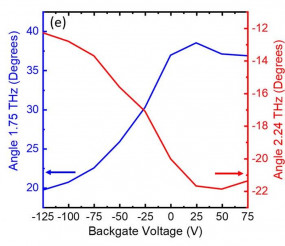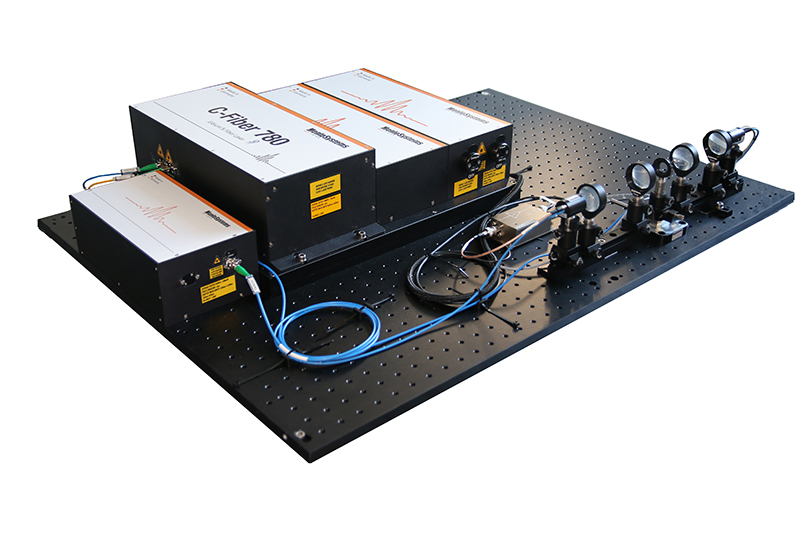Menlo Systems product:
Original publication:
Towards all-electric THz polarization control: Novel 2D graphene-based metamaterial as THz modulator
The University of Cambridge and Lancaster University (UK) researchers successfully developed a novel photonic modulator analyzed with Menlo Systems’ terahertz time-domain spectrometer.
Terahertz radiation manipulation is an emerging research field with applications in communications, material sciences, biochemical spectroscopy or imaging. The development of novel, photonic materials to control THz polarization is an important step towards the manipulation of THz waves. Researchers from Cambridge and Lancaster designed a graphene-based 2D metamaterial that enables active manipulation of the THz polarization of a quantum cascade laser (QCL) with modulation rates in the MHz-range. Comparisons of experimental results to simulations have shown good agreement. Menlo Systems’ broadband THz-TDS system has been used for the successful measurements
THz wireless communication requires rapid light manipulation for example in multiplexing techniques and communication protocols. Moreover, controlled THz polarization manipulations can also be game changing in material science and probing of biomolecules. This work addresses the demand for actively controllable polarizers and for non-integrated and fast devices.
Existing modulators are often of static nature and come integrated into a single THz source typically providing Hz-range modulation frequencies. An alternative approach includes the application of photoactive material, e.g. silicon, in micromechanical systems. While the first approach requires the use of a laser pump, the latter one typically achieves modulation speeds in the range of 10-100 kHz. Using the outstanding, electronic tunability of graphene through its conductivity, higher modulation speeds become available. The 2D device is composed 27 cells of Ti/Au resonators with topped graphene patches on a total area of 1.7 mm², as shown in Figure 1. In order to control the polarization, the group has applied an approach based on a coupled resonator structure (shown on scheme below). The incident THz wave excites the bright resonator in the initial polarization direction Ey, whereas capacitive coupling indirectly excites the two C-shaped dark resonators. These latter resonators re-emit THz radiation with an E-field component along x (Ex). The overall effect is a modulation of the polarization of the THz wave. The tunability of graphene can be used to actively control the degree of the polarization change by modifying its conductivity.
 Figure 1
Figure 1
The assessment of the device was carried out by comparing simulations by finite element method (FEM), LCR equivalent circuit model, and the experimental analysis of the transmitted E-fields in x- and y-directions with the TERA K15 THz-TDS spectrometer. The results presented in Figure 2 show a very good agreement between the E-field obtained by the theoretical model and the measured values as a function of the frequency and the conductivity. Theoretical findings reveal resonant frequencies at 1.75 THz and 2.24 THz. A slight blue shift in the TDS results was observed caused by permittivity differences between the model and the measurement. Maximum polarization rotation is obtained under low graphene conductivity as expected. This effect can be explained by the factor of damping of the black resonator: in other words, high graphene conductivity switches off the dark resonator and therefore results in a decreased Ex amplitude, which is proportional to the polarization variation from the initial direction Ey.
 Figure 2
Figure 2
 Figure 3
Figure 3
The theoretical prediction and the experimental results are shown in Figure 2 as a function of the graphene conductivity, modulated via electro-static back-gating. Figure 3 shows the extracted polarization rotation angles at the two resonant frequencies of 1.75 and 2.24 THz as a function of the back-gate voltage. The maximum polarization rotation achieved was larger than 20 degrees, whilst maintaining the ellipticity value below 0.1. The device was further successfully integrated with a THz quantum cascade laser emitting around 2.2 THz, showing consistent results with the measurements performed with the terahertz spectrometer, and reconfiguration speed around 5 MHz. The modulation frequency has been improved in contrast to other methods from the kHz-range to a few MHz paving the way to ultra-fast, all-electric THz modulators.
Author: Milan Öri
Original publication:
S. J. Kindness et al.: Graphene-Integrated Metamaterial Device for All-Electrical Polarization Control of Terahertz Quantum Cascade Lasers; ACS Photonics Vol. 6, pp. 1547−1555 (2019)
DOI: https://pubs.acs.org/doi/10.1021/acsphotonics.9b00411
(Reuse permission should be directed to the ACS)
